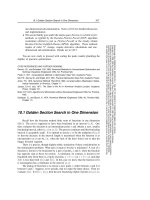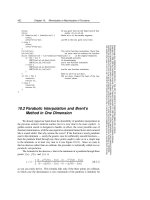Lập Trình C# all Chap "NUMERICAL RECIPES IN C" part 171 doc
Bạn đang xem bản rút gọn của tài liệu. Xem và tải ngay bản đầy đủ của tài liệu tại đây (75.31 KB, 4 trang )
10.3 One-Dimensional Search with First Derivatives
405
Sample page from NUMERICAL RECIPES IN C: THE ART OF SCIENTIFIC COMPUTING (ISBN 0-521-43108-5)
Copyright (C) 1988-1992 by Cambridge University Press.Programs Copyright (C) 1988-1992 by Numerical Recipes Software.
Permission is granted for internet users to make one paper copy for their own personal use. Further reproduction, or any copying of machine-
readable files (including this one) to any servercomputer, is strictly prohibited. To order Numerical Recipes books,diskettes, or CDROMs
visit website or call 1-800-872-7423 (North America only),or send email to (outside North America).
etemp=e;
e=d;
if (fabs(p) >= fabs(0.5*q*etemp) || p <= q*(a-x) || p >= q*(b-x))
d=CGOLD*(e=(x >= xm ? a-x : b-x));
The above conditions determine the acceptability of the parabolic fit. Here we
take the golden section step into the larger of the two segments.
else {
d=p/q; Take the parabolic step.
u=x+d;
if (u-a < tol2 || b-u < tol2)
d=SIGN(tol1,xm-x);
}
} else {
d=CGOLD*(e=(x >= xm ? a-x : b-x));
}
u=(fabs(d) >= tol1 ? x+d : x+SIGN(tol1,d));
fu=(*f)(u);
This is the one function evaluation per iteration.
if (fu <= fx) { Now decide what to do with our func-
tion evaluation.if (u >= x) a=x; else b=x;
SHFT(v,w,x,u) Housekeeping follows:
SHFT(fv,fw,fx,fu)
} else {
if (u < x) a=u; else b=u;
if (fu <= fw || w == x) {
v=w;
w=u;
fv=fw;
fw=fu;
} else if (fu <= fv || v == x || v == w) {
v=u;
fv=fu;
}
} Done with housekeeping. Back for
another iteration.}
nrerror("Too many iterations in brent");
*xmin=x; Never get here.
return fx;
}
CITED REFERENCES AND FURTHER READING:
Brent, R.P. 1973,
Algorithms for Minimization without Derivatives
(Englewood Cliffs, NJ: Prentice-
Hall), Chapter 5. [1]
Forsythe, G.E., Malcolm, M.A., and Moler, C.B. 1977,
Computer Methods for Mathematical
Computations
(Englewood Cliffs, NJ: Prentice-Hall), §8.2.
10.3 One-Dimensional Search with First
Derivatives
Here we want to accomplish precisely the same goal as in the previous
section, namely to isolate a functional minimum that is bracketed by the triplet of
abscissas (a, b, c), but utilizing an additional capability to compute the function’s
first derivative as well as its value.
406
Chapter 10. Minimization or Maximization of Functions
Sample page from NUMERICAL RECIPES IN C: THE ART OF SCIENTIFIC COMPUTING (ISBN 0-521-43108-5)
Copyright (C) 1988-1992 by Cambridge University Press.Programs Copyright (C) 1988-1992 by Numerical Recipes Software.
Permission is granted for internet users to make one paper copy for their own personal use. Further reproduction, or any copying of machine-
readable files (including this one) to any servercomputer, is strictly prohibited. To order Numerical Recipes books,diskettes, or CDROMs
visit website or call 1-800-872-7423 (North America only),or send email to (outside North America).
In principle, we might simply search for a zero of the derivative, ignoring the
function value information, using a root finder like rtflsp or zbrent (§§9.2–9.3).
It doesn’t take longto reject that idea: How do we distinguishmaxima from minima?
Where do we go from initial conditions where the derivatives on one or both of
the outer bracketing points indicate that “downhill” is in the direction out of the
bracketed interval?
We don’t want to give up our strategy of maintaining a rigorous bracket on the
minimum at all times. The only way to keep such a bracket is to update it using
function (not derivative) information, with the central point in the bracketing triplet
always that with the lowest function value. Therefore the role of the derivatives can
only be to help us choose new trial points within the bracket.
One school of thoughtisto “use everythingyou’ve got”: Computea polynomial
of relatively high order (cubic or above) that agrees with some number of previous
function and derivative evaluations. For example, there is a unique cubic that agrees
with function and derivative at two points, and one can jump to the interpolated
minimum of that cubic (if there is a minimum within the bracket). Suggested by
Davidon and others, formulas for this tactic are given in
[1]
.
We like to be more conservative than this. Once superlinear convergence sets
in, it hardly matters whether its order is moderately lower or higher. In practical
problems that we have met, most function evaluations are spent in getting globally
close enough to the minimum for superlinear convergence to commence. So we are
more worried about all the funny “stiff” things that high-order polynomials can do
(cf. Figure 3.0.1b), and about their sensitivities to roundoff error.
This leads us to use derivative information only as follows: The sign of the
derivative at the central point of the bracketing triplet (a, b, c) indicates uniquely
whether the next test point should be taken in the interval (a, b) or in the interval
(b, c). The value of this derivative and of the derivative at the second-best-so-far
point are extrapolated to zero by the secant method (inverse linear interpolation),
which by itself is superlinear of order 1.618. (The golden mean again: see
[1]
, p. 57.)
We impose the same sort of restrictions on this new trial point as in Brent’s method.
If the trial point must be rejected, we bisect the interval under scrutiny.
Yes, wearefuddy-duddieswhenit comesto makingflamboyant useof derivative
information in one-dimensional minimization. But we have met too many functions
whose computed “derivatives” don’t integrate up to the function value and don’t
accurately point the way to the minimum, usually because of roundoff errors,
sometimes because of truncation error in the method of derivative evaluation.
You will see that the following routine is closely modeled on brent in the
previous section.
#include <math.h>
#include "nrutil.h"
#define ITMAX 100
#define ZEPS 1.0e-10
#define MOV3(a,b,c, d,e,f) (a)=(d);(b)=(e);(c)=(f);
float dbrent(float ax, float bx, float cx, float (*f)(float),
float (*df)(float), float tol, float *xmin)
Given a function
f and its derivative function df, and given a bracketing triplet of abscissas ax,
bx, cx [such that bx is between ax and cx,andf(bx) is less than both f(ax) and f(cx)],
this routine isolates the minimum to a fractional precision of about
tol using a modification of
Brent’s method that uses derivatives. The abscissa of the minimum is returned as
xmin,and
10.3 One-Dimensional Search with First Derivatives
407
Sample page from NUMERICAL RECIPES IN C: THE ART OF SCIENTIFIC COMPUTING (ISBN 0-521-43108-5)
Copyright (C) 1988-1992 by Cambridge University Press.Programs Copyright (C) 1988-1992 by Numerical Recipes Software.
Permission is granted for internet users to make one paper copy for their own personal use. Further reproduction, or any copying of machine-
readable files (including this one) to any servercomputer, is strictly prohibited. To order Numerical Recipes books,diskettes, or CDROMs
visit website or call 1-800-872-7423 (North America only),or send email to (outside North America).
the minimum function value is returned as dbrent, the returned function value.
{
int iter,ok1,ok2; Will be used as flags for whether pro-
posed steps are acceptable or not.float a,b,d,d1,d2,du,dv,dw,dx,e=0.0;
float fu,fv,fw,fx,olde,tol1,tol2,u,u1,u2,v,w,x,xm;
Comments following will point out only differences from the routine brent.Readthat
routine first.
a=(ax < cx ? ax : cx);
b=(ax > cx ? ax : cx);
x=w=v=bx;
fw=fv=fx=(*f)(x);
dw=dv=dx=(*df)(x); All our housekeeping chores are dou-
bled by the necessity of moving
derivative values around as well
as function values.
for (iter=1;iter<=ITMAX;iter++) {
xm=0.5*(a+b);
tol1=tol*fabs(x)+ZEPS;
tol2=2.0*tol1;
if (fabs(x-xm) <= (tol2-0.5*(b-a))) {
*xmin=x;
return fx;
}
if (fabs(e) > tol1) {
d1=2.0*(b-a); Initialize these d’s to an out-of-bracket
value.d2=d1;
if (dw != dx) d1=(w-x)*dx/(dx-dw); Secant method with one point.
if (dv != dx) d2=(v-x)*dx/(dx-dv); And the other.
Which of these two estimates of d shall we take? We will insist that they be within
the bracket, and on the side pointed to by the derivative at x:
u1=x+d1;
u2=x+d2;
ok1 = (a-u1)*(u1-b) > 0.0 && dx*d1 <= 0.0;
ok2 = (a-u2)*(u2-b) > 0.0 && dx*d2 <= 0.0;
olde=e; Movement on the step before last.
e=d;
if (ok1 || ok2) { Take only an acceptable d,andif
both are acceptable, then take
the smallest one.
if (ok1 && ok2)
d=(fabs(d1) < fabs(d2) ? d1 : d2);
else if (ok1)
d=d1;
else
d=d2;
if (fabs(d) <= fabs(0.5*olde)) {
u=x+d;
if (u-a < tol2 || b-u < tol2)
d=SIGN(tol1,xm-x);
} else { Bisect, not golden section.
d=0.5*(e=(dx >= 0.0 ? a-x : b-x));
Decide which segment by the sign of the derivative.
}
} else {
d=0.5*(e=(dx >= 0.0 ? a-x : b-x));
}
} else {
d=0.5*(e=(dx >= 0.0 ? a-x : b-x));
}
if (fabs(d) >= tol1) {
u=x+d;
fu=(*f)(u);
} else {
u=x+SIGN(tol1,d);
fu=(*f)(u);
if (fu > fx) { If the minimum step in the downhill
direction takes us uphill, then
we are done.
*xmin=x;
return fx;
408
Chapter 10. Minimization or Maximization of Functions
Sample page from NUMERICAL RECIPES IN C: THE ART OF SCIENTIFIC COMPUTING (ISBN 0-521-43108-5)
Copyright (C) 1988-1992 by Cambridge University Press.Programs Copyright (C) 1988-1992 by Numerical Recipes Software.
Permission is granted for internet users to make one paper copy for their own personal use. Further reproduction, or any copying of machine-
readable files (including this one) to any servercomputer, is strictly prohibited. To order Numerical Recipes books,diskettes, or CDROMs
visit website or call 1-800-872-7423 (North America only),or send email to (outside North America).
}
}
du=(*df)(u); Now all the housekeeping, sigh.
if (fu <= fx) {
if (u >= x) a=x; else b=x;
MOV3(v,fv,dv, w,fw,dw)
MOV3(w,fw,dw, x,fx,dx)
MOV3(x,fx,dx, u,fu,du)
} else {
if (u < x) a=u; else b=u;
if (fu <= fw || w == x) {
MOV3(v,fv,dv, w,fw,dw)
MOV3(w,fw,dw, u,fu,du)
} else if (fu < fv || v == x || v == w) {
MOV3(v,fv,dv, u,fu,du)
}
}
}
nrerror("Too many iterations in routine dbrent");
return 0.0; Never get here.
}
CITED REFERENCES AND FURTHER READING:
Acton, F.S. 1970,
Numerical Methods That Work
; 1990, corrected edition (Washington: Mathe-
matical Association of America), pp. 55; 454–458. [1]
Brent, R.P. 1973,
Algorithms for Minimization without Derivatives
(Englewood Cliffs, NJ: Prentice-
Hall), p. 78.
10.4 Downhill Simplex Method in
Multidimensions
With this section we begin consideration of multidimensional minimization,
that is, finding the minimum of a function of more than one independent variable.
This section stands apart from those which follow, however: All of the algorithms
after this section willmake explicit use of a one-dimensionalminimizationalgorithm
as a part of their computational strategy. This section implements an entirely
self-contained strategy, in which one-dimensional minimization does not figure.
The downhill simplex method is due to Nelder and Mead
[1]
. The method
requires only function evaluations, not derivatives. It is not very efficient in terms
of the number of function evaluations that it requires. Powell’s method (§10.5) is
almost surelyfaster inall likelyapplications. However, thedownhill simplexmethod
may frequently be the best method to use if the figure of merit is “get something
working quickly” for a problem whose computational burden is small.
The method has a geometrical naturalness about it which makes it delightful
to describe or work through:
A simplex is the geometrical figure consisting, in N dimensions, of N +1
points (or vertices) and all their interconnecting line segments, polygonal faces, etc.
In two dimensions, a simplex is a triangle. In three dimensions it is a tetrahedron,
not necessarily the regular tetrahedron. (The simplex method of linear programming,









